How ‘Masters of the Air’ Created a Groundbreaking WWII Epic
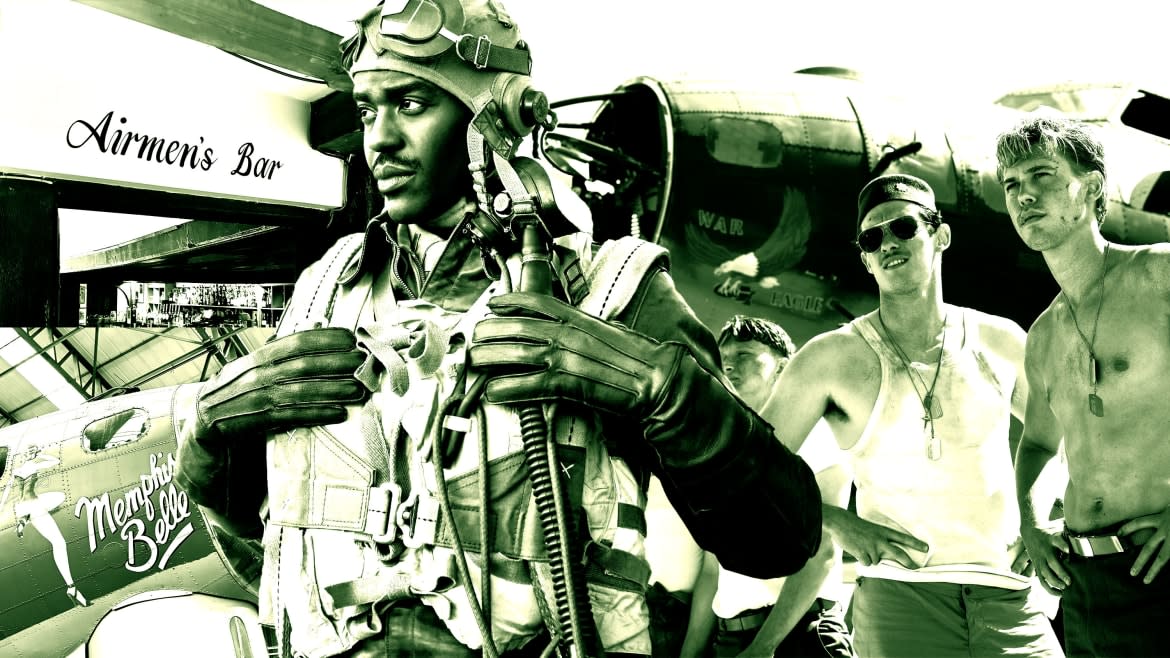
- Oops!Something went wrong.Please try again later.
“Oversexed, overpaid, and over here” was a common refrain that underscored the tension between stationed U.S. troops and British locals during World War II. It is a phrase uttered in the Apple TV+ historical epic Masters of the Air when American Major Harry Crosby (Anthony Boyle) ventures out of East Anglia to Oxford’s hallowed academic grounds as part of an allied conference. However, the interactions between the U.S. airmen and the locals in Thorpe Abbotts, Norfolk, were far from prickly, and close bonds remain more than 80 years later.
When Major John “Bucky” Egan (Callum Turner) and his best friend, Major Gale “Buck” Cleven (Austin Butler), depart Thorpe Abbotts at the end of the series (and in real life), locals turned out in their Sunday best to wave farewell to the 100th Bomb Group, who had called this slice of rural East Anglia home for the last two years. Cows graze beside the burned-out wreckage of a B-17 Flying Fortress, offering a reminder of the losses that inspired the “Bloody Hundredth” nickname—as well as what was here before the war came.
Lying about 100 miles north of London, Thorpe Abbotts is Masters of the Air’s beating heart, and the control tower from that historic time still stands today. In fact, if you venture to the East of England, you can still climb to the same viewing platform as Crosby and the show’s characters did in 1943.
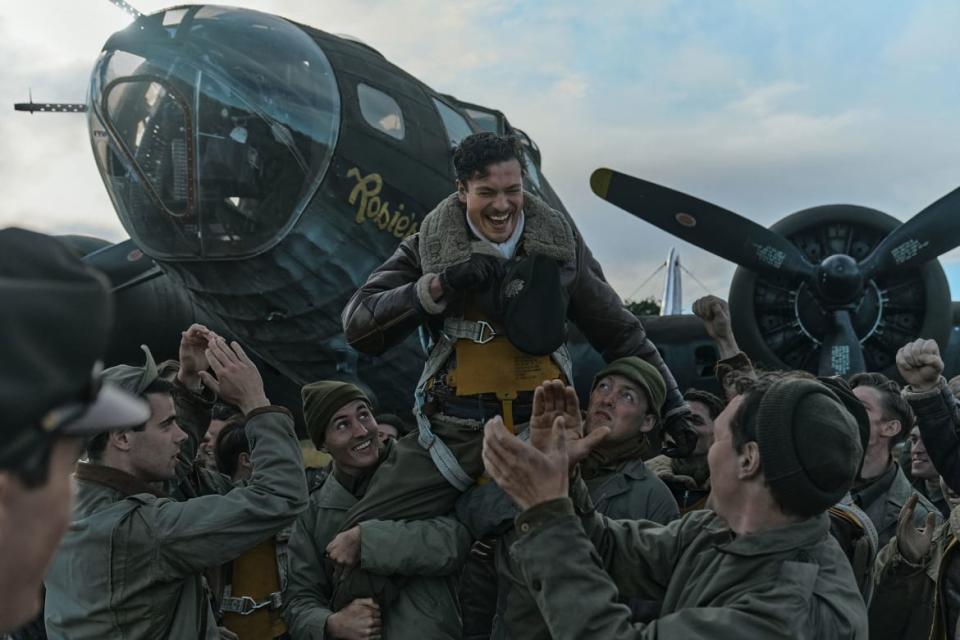
Nate Mann in 'Masters of the Air'
“That was the big thing, the way that the Americans embraced the community, and of course, the community let them in,” Masters of the Air production designer Chris Seagers tells The Daily Beast Obsessed. Seagers grew up in this part of England and has first-hand knowledge of the landscape and the farmland that became a vital hub for the United States Air Force in the early 1940s. “You knew of the history because there are so many airfields around here, and as kids, we grew up on those airfields because they were just great places to mess about on,” Seagers says.
With 350,000 Americans descending on East Anglia and up to 3,500 billeted to each base, the flat, lush green landscape was quickly transformed into concrete runways and barracks. Evidence of the “Friendly Invasion,” as this is known, remains across the region. Around 150 miles away, RAF Abingdon and Newland Park in Oxfordshire doubled as the airfield in the series. Still, Thorpe Abbotts was pivotal in the pre-production stage. Visitors can explore the real location and the indelible legacy that informs much of the nine-part series from executive producers Steven Spielberg, Tom Hanks, and Gary Goetzman.
Nearly a decade ago, show creator John Orloff first visited eastern England as part of an “unbelievably invaluable” research trip with Masters of the Air author Donald L. Miller and producer Kirk Saduski. “It wasn’t just going to Thorpe Abbotts. It was going to Diss, Norwich, Cambridge, and seeing all the different places—it wasn’t just the 100th—and soaking it all in,” Orloff says.
I traveled to some of the same spots over the last few weeks. Even though I have lived in Norwich since 2001, my knowledge of the region’s role in World War II was minimal. I got to put this right with local experts and the Masters of the Air creative team, who told me how they used historical locations to bring the series to life. As well as visiting the Thorpe Abbotts Memorial Museum, I headed to the Cambridge American Cemetary, IWM Duxford, and several drinking establishments frequented by airmen in the 1940s. “Obviously, the pubs got used immensely,” Seagers says.
‘Masters of the Air’ Is Making the Next Generation of Hollywood Stars
“When I first read the scripts, I gotta be honest, I sat down and thought, ‘How the hell do we do this?’ Because it was so complicated.” Thankfully, the Masters of the Air team found a way.
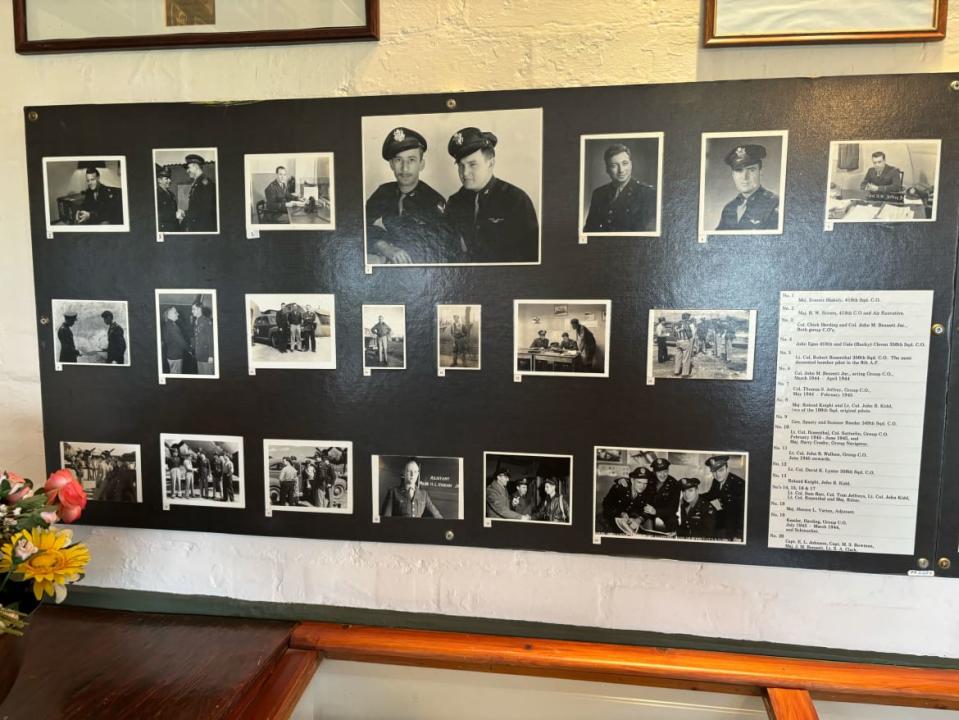
Thorpe Abbotts: The Real Place
“Going to Thorpe Abbotts, it’s a lot of things actually because firstly, it’s the emotional hepart of it,” Orloff says. By the time Orloff came to research Masters of the Air, the men at the center of their story had died. By contrast, on 2001’s acclaimed Band of Brothers, the previous World War II epic series produced by the Hanks and Spielberg dream team, some of the real people were still alive. Still, the commitment to “getting it right” doesn’t change.
The volunteer-run Thorpe Abbotts Memorial Museum provides a tangible connection to the real people who are dramatized in the series through the original control tower and the personal artifacts in its vast collection. Egan and Cleven’s flying school graduation rings (on temporary loan) highlight a deep bond that isn’t just a Hollywood invention, and Robert “Rosie” Rosenthal’s (played by Nate Mann) uniform sits alongside the decorated airman’s medals, and a photograph of the lawyer at Nuremberg. “To see the actual physical things that these people held, touched, and wore is very emotional,” Orloff says.
The showrunner spent hours studying the treasure trove of materials. Some of the more obscure books on sale in the gift shop proved invaluable (Orloff used 30 different sources to create a show bible). So was talking to the people who maintain this museum. “There’s the whole other level of these volunteers who have made it their passion and hobby and devoted so much time and effort to keep it alive,” Orloff says.
I visited in March, as the Memorial Museum opened for the 2024 season, and the Masters of the Air impact—the series had already premiered at that point—was already in full effect.
A double rainbow graced the gray Norfolk skies on the opening Saturday, which felt rather poetic amid the rain and bluster. The following day, I spoke to Thorpe Abbotts’ trustee, Debra Hubbard, whose father, Mike Harvey, spearheaded the volunteers’ project to restore the control tower nearly 50 years ago: after four years’ work, it re-opened to the public in 1981.
“There’s a lot more movie buffs who don’t necessarily know too much about the 100th,” she says. “But hopefully, by the time they’ve been around here and spoken to our volunteers, they go away with a better understanding. We’re here as a memorial to the men. Or, as I call them, ‘Our boys.’”
Talking to Hubbard, curator Ron Batley, and other volunteers underscored the deep bond that still exists between the 100th Bomb Group and the local Norfolk community. Still, Hubbard is keen to point out that Thorpe Abbotts is not the only spot with World War II ties to American servicemen in the region: “We hope that when people are here for us, they visit the other bases and get an interest in them because everybody who lost their lives or even just came to this country to protect us deserves recognition.”
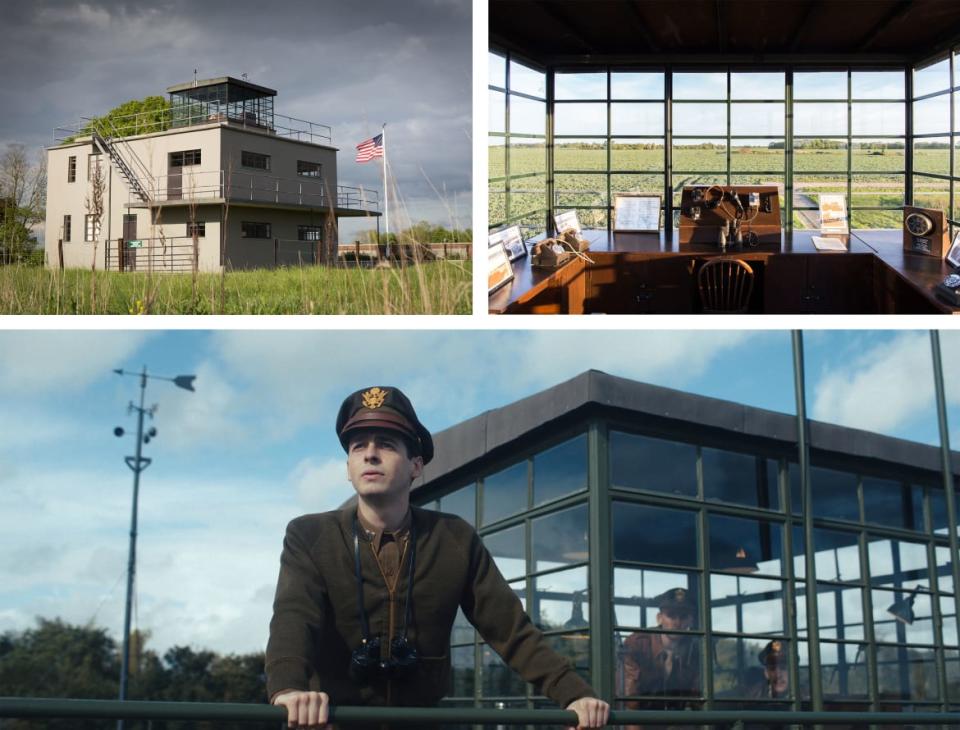
Thorpe Abbotts: Building the Set
In the Thorpe Abbotts Control Tower, a model of how the airfield appeared during the war offers an eye-opening visual of the enormous operation. It covered over 500 acres of land with three runaways, three-and-a-half miles of perimeter track, and 50 hardstands (each one for an aircraft). Only the perimeter track remains, but this model indicates how massive the site was at its peak, and the challenge the Masters of the Air team faced in recreating its size.
The ability to capture a continuous shot between interiors and exteriors aided this goal, adding to the immersive experience for actors and the audience alike. “We were trying to create so you could do it all on this one set, so you felt you were going by truck from the airfield to a barracks hut. You got a sense of the journey because it was an enormous site, acres, and acres of it,” Seagers says.
The main set comprised about a dozen buildings, underscoring the authentic design. “Normally, in film, you wouldn’t build something like this. You would build three buildings and then just redress those three buildings,” Orloff says. Each set was entirely “propped out,” so stepping into any of those buildings was like entering a timewarp.
Raff Law Breaks Down That Devastating Episode of ‘Masters of the Air’
When Hubbard visited the set with curator Batley, the pair were overwhelmed by the experience. “We walked into the operations room, and I looked at Ron, and Ron looked at me, and we both cried,” she says. “Suddenly, we were in a place we’d known for 40-odd years, and every photo we’d seen came to life.” Filing cabinets were filled with paperwork detailing actual missions no matter where it sat in the stack. Orloff mentions that having this level of prop accuracy also helps if an actor wants to improvise in a scene, as it doesn’t pull them out of the past. “He [Seagers] said he’d never worked on a production where they’ve had access to so much original information that they felt they couldn’t do anything but a good job,” Hubbard recalls.
Seagers used original RAF drawings and photographs from Thorpe Abbotts to bring the base to life. “You could literally walk around it. It was almost like the people just walked up and left. It was very eerie, especially late in the afternoon when the sun was going down,” Seagers says.
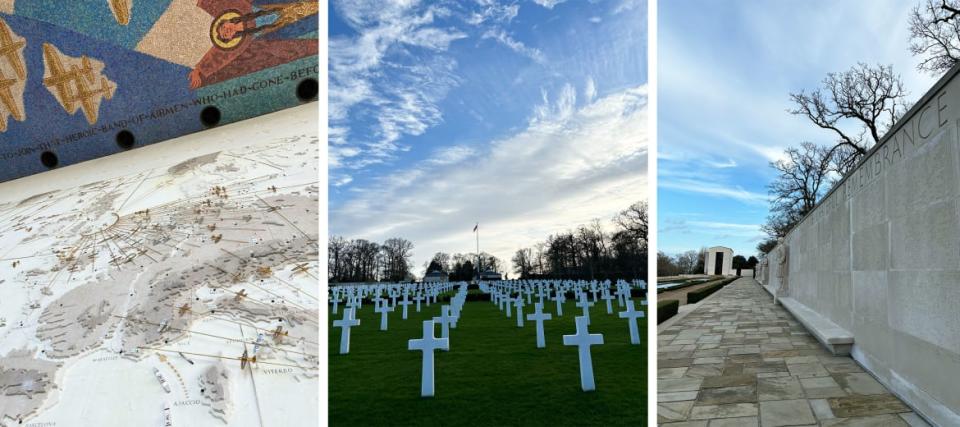
Memorials
Some men never did leave the region. In happier cases, they met their future wife in a Norfolk pub, or in more tragic circumstances, they were one of the approximately 30,000 U.S. airmen and women who died in World War II. The rows of white marble headstones at the Cambridge American Cemetry and Memorial are a sobering reminder of the losses. The cemetery contains the remains of 3,812 U.S. personnel, and an additional 5,127 names are etched into the Wall of the Missing (including Joseph Kennedy Jr. and Glenn Miller).
When I got to the American Cemetery, the February skies had shifted from murky to bright blue, and only the sound of traffic from a nearby road broke the solemn spell. Within the memorial building that was dedicated in 1956, a map of Europe shows how wide-ranging the air operation was, and a stunning mosaic on the ceiling honors the dead.
Shining like a beacon on the horizon is Ely Cathedral, which World War II pilots used as a navigation landmark. From a distance, it looks majestic, and a trip there offers a slice of recent movie and TV history. Ely Cathedral doubled for Westminster Abbey in Season 1 of The Crown, and in The King’s Speech, and it plays itself during a climatic concert scene in the Oscar-nominated Maestro. Even if you haven’t seen the movie, you probably have seen the sequence in which Bradley Cooper recreates Leonard Bernstein’s 1973 concert.
Several pubs pay homage to the men who drank in them back in the 1940s. Periods of intense warfare contrasted with the relative comfort in the surrounding English countryside, which is an element that sets Masters of the Air apart from this creative team’s other World War II series. “They come back and are thrust into civilization and in a world that’s not in combat as directly,” Orloff says. “We see them going off to London on a weekend pass or the local pub for a few pints to shake off what they witnessed.”
It was a challenge, however, to find a pub in the 2020s that could double for a 1940s boozer. “It was a little tricky because the Suffolk pubs are quite unique,” Seager says. While many bars have had makeovers over the years, some local choices still feel like they’re from another age. The Airmen’s Bar at The Swan at Lavenham, Suffolk, celebrates the men, with signatures from the 487th Bomb Group in 1943 on display, complete with some New Jersey and New York City addresses. If ale isn’t your thing, an American servicemen-themed afternoon tea might whet your appetite. Pop culture aficionados will also get a kick out of the Dolly Parton telegram on the wall dating back to her stay at The Swan in the 1980s.
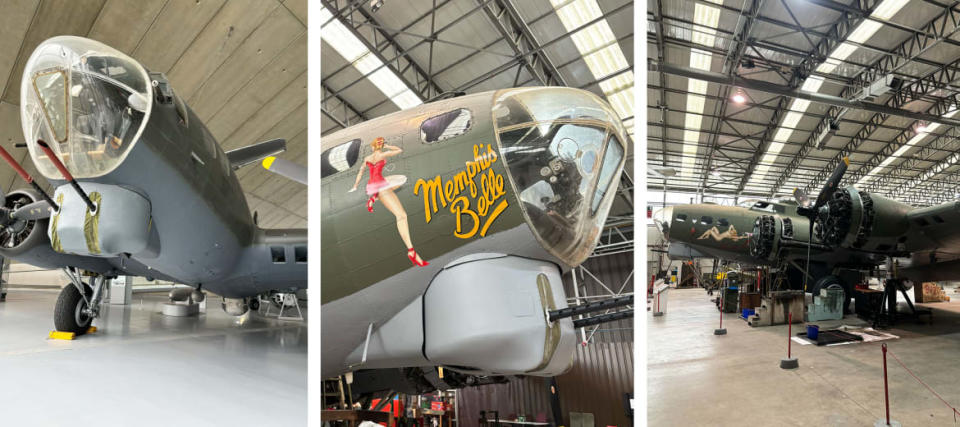
Building Planes From Scratch
While the men we see in Masters of the Air took in the local hot spots, they also spent a lot of time in the Flying Fortresses. Less than 10 miles from Cambridge, at IWM Duxford, you can get a feel for the aircraft these men flew in 1943. It is home to the Sally B, the only airworthy B-17 in Europe (and appeared in the 1990 movie Memphis Belle), and a second B-17 is part of the American Air Museum collection.
IWM Duxford proved significant to the Masters of the Air team as their main source of B-17 research. “We had aspirations of having a proper aerial plane, but it became clear very quickly they were not going to allow us to fly one for insurance purposes,” Seagers says. “They wouldn’t allow actors on them because they’re too dangerous.” While they couldn’t fly an actual B-17, this didn’t mean they couldn’t build one from scratch.
‘Masters of the Air’ Is Good Enough to Be the Next ‘Band of Brothers’
Orloff explains that the aluminum wings would droop without the Boeing-specific ribbed pattern design. “We got the drawings from Boeing and built the planes as they had built them because that’s the only way to do it,” Seagers says. This part of the process also brought home how little protection the men had. “They were essentially Coca-Cola cans. When you could touch the walls, and the walls were bendy. I don’t know how they did it.”
Time and time again in Masters of the Air, we see men like Rosie (literally) swinging back onto the plane and making this trip, further highlighting the enduring legacy in eastern England, and why the Masters of the Air team was so dedicated to historical accuracy.
“It needs to look like it was. We obviously will use artistic license, and there will be times when we have to bend the rules—because we’re making a story—but wherever we can, it’s got to feel real,” Seagers says. “That’s why we put so much effort [into it]; it was not only the aircraft, but also the whole base.”
Get the Daily Beast's biggest scoops and scandals delivered right to your inbox. Sign up now.
Stay informed and gain unlimited access to the Daily Beast's unmatched reporting. Subscribe now.

